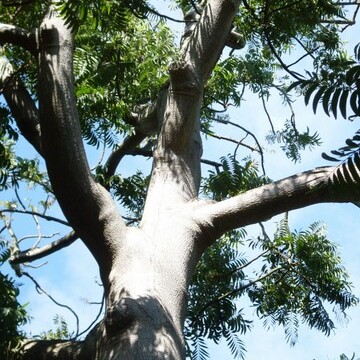Trees, evergreen, usually 15-20(-45) m tall. Leaves pinnate, 30-60 cm; leaflets 6-17(-30) pairs; petiolule pubescent, 5-7 mm; blades ovate-lanceolate or oblong-lanceolate, 15-20 × 2.5-5.5 cm, thinly leathery, base broadly cuneate or slightly rounded, oblique, margin entire, apex acuminate, abaxially ± shortly pubescent or glabrous. Panicles axillary, ± shortly pubescent, 25-50 cm; bracts small, ovate or deltoid, 5-7 mm, early caducous. Pedicel ca. 2 mm. Calyx abaxially pilose, 5-lobed, lobes shorter than 1 mm, deltoid, as long as tube. Petals 5, glabrous or nearly so, ca. 2.5 × 1-1.5 mm, valvate. Stamens 10, inserted at base of disk; filaments gracile, curved and folded in buds, lower part pilose, 1-3 mm in females, 3-6 mm in males; anthers ca. 1 mm in male, shorter in female. Carpels 3, glabrous, 2-2.5 mm; styles free or connate at base; stigmas 3-lobed, lobes shield-shaped, ca. 2 mm wide. Samarium 4.5-8 × 1.5-2.5 cm, both tops slightly obtuse. Seeds flat, surrounded by wing. Fl. Oct-Nov, fr. Jun-Mar.
Evergreen tree to 30 m high, rarely to 45 m. Leaves with 6–30 pairs of leaflets, to 70 cm long; leaflets mostly ovate-lanceolate to oblong-lanceolate, falcate, acuminate, entire, 3–15 cm long, rarely more, glabrous or pubescent below; base cuneate, oblique; stipules caducous, c. 0.5 mm long. Calyx lobes less than 1 mm long. Petals elliptic, 2.5–5 mm long, glabrous or nearly so. Stamens 3–6 mm long, shorter in female flowers. Carpels 2–4, glabrous; styles connate or free at base; stigmas connate, peltate. Samara 4.5–8 cm long, 1.5–2.5 cm wide.
An evergreen tree. It grows 15-20 m tall. The leaves are 30-60 cm long. The leaves have 6-17 pairs of leaflets along the stalk. The leaflets are oval and 15-20 cm long by 3-6 cm wide. They are wedge shaped or rounded at the base and taper to the tip. The flower panicles are in the axils of leaves. The fruit are 5-8 cm by 2-3 cm. The seeds are flat with a wing around them.

